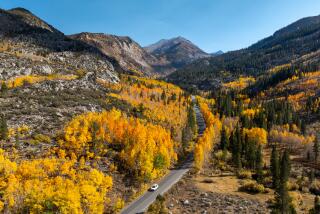Leaves’ Lack of Hue Raises a Bit of a Cry
- Share via
BRETTON WOODS, N.H. — In front of the grand old Mount Washington Hotel, a single tree blazed bright, bold and so brilliantly vermilion that it might have leaped off an artist’s palette.
The tree was a marvel, tourists recently agreed in half a dozen languages as they lined up patiently to pose before it. In its lone glory, the dazzling sugar maple symbolized a seasonal spectacle that is New England’s deepest and most abiding source of pride.
The tree’s solitary majesty--one deep red maple, where in most autumns there would be hundreds--also was Mother Nature’s version of a sigh of relief for a narrowly averted PR disaster.
Predictions of a muted leaf season this year sent tourist organizations and innkeepers into a tizzy. Botanists feared that a summer drought would rob the region’s trees of the combination of elements needed to produce the wild explosion of colors that draws visitors from around the world.
Tourism is a multibillion-dollar industry here, and leaf peepers contribute mightily; they drop about $850 million in New Hampshire alone each year and leave Maine $600 million richer as well.
“Without the leaf peepers, there would be a huge ripple effect,” said Susan Benson, a spokeswoman for Maine’s Department of Conservation who is better known as that state’s “leaf lady.”
Throughout the region, quaint villages aggressively pander to the leaf industry. Leaf products--wreaths, jewelry and a seemingly endless array of calendars and photographs--are sold at every crossroad. Leaf buses clog the twisted roads of Vermont’s Green Mountains. Leaf trains chug through the White Mountains here. Leaf experts regale the visitors with leaf lore.
It’s easy to see why the prospect of a dull season could produce pandemonium.
“It’s about regional pride, it’s about identity, and, yes, it’s about money,” Benson said. “Let’s just say that for us to start reading about this on a nationwide basis--in news reports and on Web sites--was very disturbing. The innkeepers were getting quite concerned.”
Mark Starrett, an assistant professor of horticulture at the University of Vermont, said that without a steady summer diet of heat, water and sun, the trees can’t produce the eye-popping hues that are synonymous with autumn in New England. As summer gives way to fall, the trees need low-intensity light by day and sharp cold at night to trigger the process that makes the leaves go crazy with color.
This year, rainfall as of Labor Day was at least six inches below normal in many areas here. Early September also brought uncommonly warm days and nights. Even the downpour brought late last month by Hurricane Floyd couldn’t make up for the long, dry summer, Starrett said, As a result, he added, “the vibrancy may not be as strong this season as it usually is.”
In New England, Mother Nature is an astonishing exterior decorator. Leaves the color of ancient amber or rich topaz are interspersed with others that look like psychedelic oranges. But it is the red leaves--magnificent tones of garnet, ruby and carnelian--that make autumn here so distinctive.
Thank the sugar maple and the red maple for those glorious shades. Both flourish in New England. Sensitive to salt, both varieties also dislike air pollution. Place them in the clean air of New England, give them their preferred regimen of water, light and weather, and they will produce a compound called anthocyanin. As a byproduct of the sugars trapped in the tree’s leaves, anthocyanin yields the strong red shades that are this area’s seasonal trademark.
At the Mount Washington Hotel, an assistant manager--who did not want his name used in deference to his employment, not to mention the economic security of the region--confessed that maybe the naysayers were right when they forecast a more subdued season.
Glancing around to make sure that no one was listening, he said, “I would definitely have to say it’s more muted than in past seasons.” Once again he looked around, then lowered his voice still more. “It’s disappointing,” he said gravely.
But a visitor from Florida was of a different mind. “I think these leaves are amazing,” said the tourist, who identified himself as Steve. “Just to see trees at all is pretty incredible.”
For leaves, timing is everything, said Judson Hale, editor of Yankee magazine in Dublin, N.H. He recalled thinking while looking out the window recently how muted the leaves looked. But a day later, Hale said, “suddenly it looked as though the Lord had started painting with an orange paintbrush.”
Starrett said the New England leaf kaleidoscope was about a week behind schedule this season.
Despite the dire predictions, officials have reported no decline in tourists, many of whom book reservations a year in advance.
At the Northern White Mountain Tourist Office in Berlin, N.H., Jackie Nadeau said that, as a lifelong resident of the region, she does detect “a somewhat muted” quality to the leaves this season. “But then you round the bend, and it’s breathtaking,” she said.
The local folks, in any event, know better than to try to outguess the elements. Trees have been around a lot longer than people, they point out, and they’ve got this leaf-color thing down to a science.
“We know it varies from year to year,” Nadeau said. “We know the trees are going to do what the trees are going to do. Personally, I laugh at the people who try to predict it.”
More to Read
Sign up for The Wild
We’ll help you find the best places to hike, bike and run, as well as the perfect silent spots for meditation and yoga.
You may occasionally receive promotional content from the Los Angeles Times.






